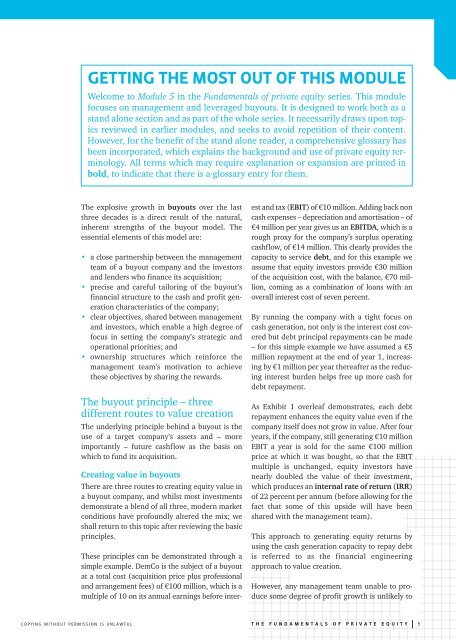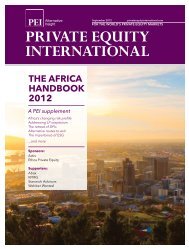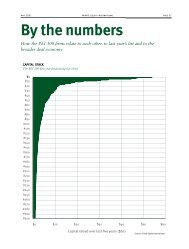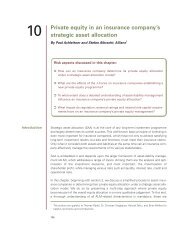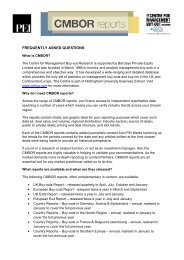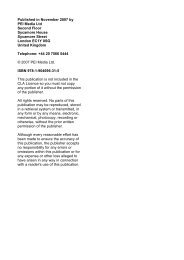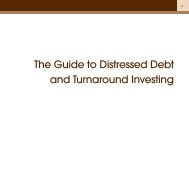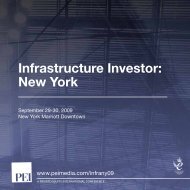Fundamentals of Private Equity and Venture Capital - PEI Media
Fundamentals of Private Equity and Venture Capital - PEI Media
Fundamentals of Private Equity and Venture Capital - PEI Media
You also want an ePaper? Increase the reach of your titles
YUMPU automatically turns print PDFs into web optimized ePapers that Google loves.
GETTING THE MOST OUT OF THIS MODULE<br />
Welcome to Module 5 in the <strong>Fundamentals</strong> <strong>of</strong> private equity series. This module<br />
focuses on management <strong>and</strong> leveraged buyouts. It is designed to work both as a<br />
st<strong>and</strong> alone section <strong>and</strong> as part <strong>of</strong> the whole series. It necessarily draws upon topics<br />
reviewed in earlier modules, <strong>and</strong> seeks to avoid repetition <strong>of</strong> their content.<br />
However, for the benefit <strong>of</strong> the st<strong>and</strong> alone reader, a comprehensive glossary has<br />
been incorporated, which explains the background <strong>and</strong> use <strong>of</strong> private equity terminology.<br />
All terms which may require explanation or expansion are printed in<br />
bold, to indicate that there is a glossary entry for them.<br />
The explosive growth in buyouts over the last<br />
three decades is a direct result <strong>of</strong> the natural,<br />
inherent strengths <strong>of</strong> the buyout model. The<br />
essential elements <strong>of</strong> this model are:<br />
• a close partnership between the management<br />
team <strong>of</strong> a buyout company <strong>and</strong> the investors<br />
<strong>and</strong> lenders who finance its acquisition;<br />
• precise <strong>and</strong> careful tailoring <strong>of</strong> the buyout’s<br />
financial structure to the cash <strong>and</strong> pr<strong>of</strong>it generation<br />
characteristics <strong>of</strong> the company;<br />
• clear objectives, shared between management<br />
<strong>and</strong> investors, which enable a high degree <strong>of</strong><br />
focus in setting the company’s strategic <strong>and</strong><br />
operational priorities; <strong>and</strong><br />
• ownership structures which reinforce the<br />
management team’s motivation to achieve<br />
these objectives by sharing the rewards.<br />
The buyout principle – three<br />
different routes to value creation<br />
The underlying principle behind a buyout is the<br />
use <strong>of</strong> a target company’s assets <strong>and</strong> – more<br />
importantly – future cashflow as the basis on<br />
which to fund its acquisition.<br />
Creating value in buyouts<br />
There are three routes to creating equity value in<br />
a buyout company, <strong>and</strong> whilst most investments<br />
demonstrate a blend <strong>of</strong> all three, modern market<br />
conditions have pr<strong>of</strong>oundly altered the mix; we<br />
shall return to this topic after reviewing the basic<br />
principles.<br />
These principles can be demonstrated through a<br />
simple example. DemCo is the subject <strong>of</strong> a buyout<br />
at a total cost (acquisition price plus pr<strong>of</strong>essional<br />
<strong>and</strong> arrangement fees) <strong>of</strong> €100 million, which is a<br />
multiple <strong>of</strong> 10 on its annual earnings before interest<br />
<strong>and</strong> tax (EBIT) <strong>of</strong> €10 million. Adding back non<br />
cash expenses – depreciation <strong>and</strong> amortisation – <strong>of</strong><br />
€4 million per year gives us an EBITDA, which is a<br />
rough proxy for the company’s surplus operating<br />
cashflow, <strong>of</strong> €14 million. This clearly provides the<br />
capacity to service debt, <strong>and</strong> for this example we<br />
assume that equity investors provide €30 million<br />
<strong>of</strong> the acquisition cost, with the balance, €70 million,<br />
coming as a combination <strong>of</strong> loans with an<br />
overall interest cost <strong>of</strong> seven percent.<br />
By running the company with a tight focus on<br />
cash generation, not only is the interest cost covered<br />
but debt principal repayments can be made<br />
– for this simple example we have assumed a €5<br />
million repayment at the end <strong>of</strong> year 1, increasing<br />
by €1 million per year thereafter as the reducing<br />
interest burden helps free up more cash for<br />
debt repayment.<br />
As Exhibit 1 overleaf demonstrates, each debt<br />
repayment enhances the equity value even if the<br />
company itself does not grow in value. After four<br />
years, if the company, still generating €10 million<br />
EBIT a year is sold for the same €100 million<br />
price at which it was bought, so that the EBIT<br />
multiple is unchanged, equity investors have<br />
nearly doubled the value <strong>of</strong> their investment,<br />
which produces an internal rate <strong>of</strong> return (IRR)<br />
<strong>of</strong> 22 percent per annum (before allowing for the<br />
fact that some <strong>of</strong> this upside will have been<br />
shared with the management team).<br />
This approach to generating equity returns by<br />
using the cash generation capacity to repay debt<br />
is referred to as the financial engineering<br />
approach to value creation.<br />
However, any management team unable to produce<br />
some degree <strong>of</strong> pr<strong>of</strong>it growth is unlikely to<br />
COPYING WITHOUT PERMISSION IS UNLAWFUL<br />
THE FUNDAMENTALS OF PRIVATE EQUITY 5


